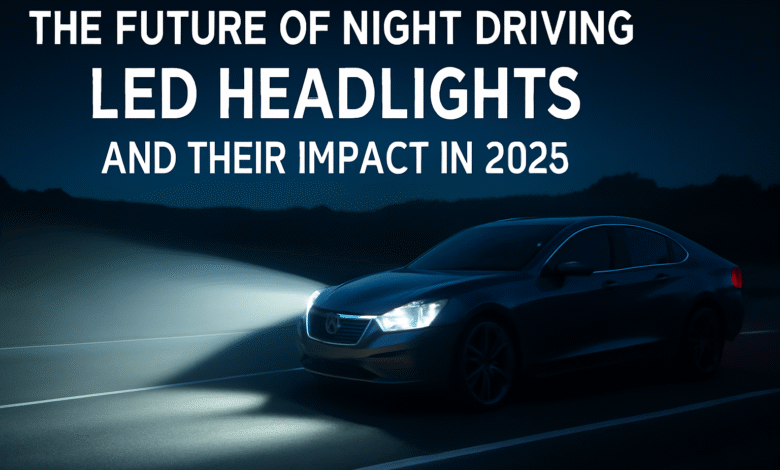The Future of Night Driving: LED Headlights and Their Impact in 2025

As we approach 2025, the automotive industry is seeing a transformative shift in the way we approach night driving. Advances in lighting technology have taken a giant leap forward, and LED headlights are at the forefront of this revolution. Whether you’re driving through city streets or on dark country roads, LED headlights are quickly becoming an essential feature in modern vehicles. Not only do they provide brighter, clearer illumination, but they also offer a range of benefits that make night driving safer and more enjoyable. In this blog, we will explore how LED headlights are shaping the future of driving, particularly for night journeys, and the profound impact they will have on drivers in the coming years.
The Advancements in LED Technology
Over the last decade, LED technology has made significant strides, and its integration into vehicle headlights is no exception. Compared to traditional halogen bulbs, LED headlights offer numerous advantages. They are more energy-efficient, provide brighter and more focused light, and last significantly longer. As LED technology continues to evolve, manufacturers are finding new ways to optimize these lights for better performance, higher efficiency, and longer durability.
LED headlights in 2025 will be far more advanced than the models we see today. New developments in color temperature will offer better visibility, mimicking daylight in terms of brightness and color quality. This not only reduces eye strain but also improves depth perception, making it easier to identify obstacles or road signs at night. Additionally, the adaptive nature of newer LED systems will allow the headlights to adjust automatically based on road conditions and traffic, providing a safer driving experience in all environments.
Why LED Headlights Are Crucial for Night Driving
Night driving has always presented a series of challenges for motorists. Low visibility, fatigue, and glare from other vehicles’ headlights can all contribute to dangerous driving conditions. LED headlights, however, are designed to address these challenges head-on.
One of the biggest advantages of LED headlights is their ability to produce a bright, focused beam of light that illuminates the road more effectively than traditional headlights. This means that drivers can see further down the road, allowing them to react quicker to any potential hazards. The sharper and more concentrated light pattern of LED headlights also reduces the chance of distractions or visual interference from the surrounding environment, making driving at night far less stressful.
Another major benefit of LED headlights is their energy efficiency. Unlike halogen lights, which burn more energy to produce light, LED lights are much more power-efficient, meaning they place less strain on a vehicle’s battery. This efficiency not only reduces fuel consumption but also contributes to the longevity of a vehicle’s electrical system, making it a more sustainable and cost-effective solution in the long run.
The Role of the Best LED Headlight Bulbs 2025 in Improving Night Driving
When we talk about night driving in 2025, one aspect that will undoubtedly stand out is the use of the best LED headlight bulbs 2025. These bulbs are not only brighter but also smarter than their predecessors. The technology behind these bulbs is designed to provide better illumination while also reducing the risk of glare for other drivers. This is essential for ensuring the safety of all road users, as bright lights can often cause discomfort or temporary blindness for oncoming drivers, increasing the risk of accidents.
The best LED headlight bulbs 2025 will be engineered with adaptive capabilities, allowing them to adjust to various road conditions in real-time. Whether you’re driving on a dark highway or a well-lit urban street, these bulbs can automatically adjust the light pattern, intensity, and angle for optimal visibility. This will enhance driver comfort, reduce fatigue, and improve reaction times, especially in low-light conditions.
Furthermore, LED headlights in 2025 will feature advanced heat dissipation mechanisms, ensuring that the bulbs don’t overheat or burn out prematurely. This innovation will contribute to longer-lasting lights, meaning fewer replacements and lower maintenance costs for car owners. These advancements are making night driving safer, easier, and more efficient than ever before.
Enhanced Road Safety with LED Technology
Safety is always a top priority when driving, and LED headlights significantly contribute to improved road safety, especially at night. With their superior illumination and ability to adjust automatically to the surrounding environment, LED headlights help drivers to spot pedestrians, animals, or road hazards well in advance. This added reaction time can be the difference between avoiding an accident or not.
The increased brightness of LED headlights is particularly useful when driving in rural or poorly lit areas where streetlights are sparse. In these areas, the ability to see further down the road is vital for both safety and comfort. LED headlights allow drivers to navigate dark roads with more confidence, reducing the chances of encountering unexpected obstacles.
Additionally, LED headlights help reduce glare for other road users. Unlike halogen headlights, which can scatter light and cause unnecessary glare, LED headlights produce a more focused beam that limits the amount of light that is wasted or directed toward other drivers’ eyes. This improvement minimizes the risk of temporary blindness and accidents caused by improper lighting.
The Environmental Impact of LED Headlights
As sustainability becomes an increasingly important consideration in the automotive industry, LED headlights are playing a crucial role in reducing a vehicle’s overall environmental impact. Traditional halogen bulbs are less energy-efficient and require more power to operate. In contrast, LED lights consume far less energy, contributing to lower fuel consumption and reduced carbon emissions.
Additionally, the longer lifespan of LED headlights means fewer bulbs need to be manufactured and replaced, resulting in less waste. Over time, the widespread adoption of LED technology in vehicles will help to reduce the overall environmental footprint of the automotive industry, making driving at night more eco-friendly.
The Future of LED Headlights in Autonomous Vehicles
Looking ahead, one of the most exciting developments in the automotive industry is the rise of autonomous vehicles. As self-driving cars become more common, LED headlights will play a crucial role in their operation. Autonomous vehicles rely on precise navigation systems, including sensors and cameras, to detect obstacles and hazards on the road. LED headlights, with their high brightness and adaptive features, will help these systems to function more effectively, ensuring the car can see and respond to its environment at night.
In addition to their role in autonomous driving, LED headlights will continue to evolve alongside other vehicle technologies. As vehicles become more connected and intelligent, it’s likely that LED headlights will integrate with other in-car systems, such as driver assistance features or automated driving modes, to create an even safer and more efficient driving experience.
What to Expect in the Coming Years
The next few years will undoubtedly bring even more advancements in LED headlight technology. In 2025 and beyond, we can expect to see further improvements in energy efficiency, light quality, and adaptive features. Manufacturers are already exploring innovations like laser-based headlights and smart lighting systems that can adjust based on the driver’s preferences and the road conditions.
For drivers, this means that night driving will become even safer, more convenient, and more enjoyable. The technology will continue to evolve, offering even more refined lighting solutions that provide superior visibility without blinding other drivers. The future of night driving is undoubtedly bright, thanks to the continued development of LED headlight technology.
Conclusion
The future of night driving in 2025 looks incredibly promising, with LED headlights playing a central role in improving safety, efficiency, and visibility. These lights are not only brighter and more energy-efficient, but they are also designed to adapt to various driving conditions, ensuring a safer experience for everyone on the road. As technology continues to evolve, LED headlights will remain at the forefront of this transformation, making night driving more comfortable and secure than ever before.
To ensure you’re equipped with the best lighting solutions for your car, it’s important to consider upgrading your headlights to the best LED headlight bulbs 2025. Visit https://shorturl.at/Zssce

